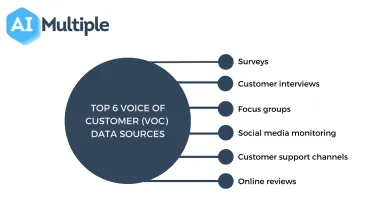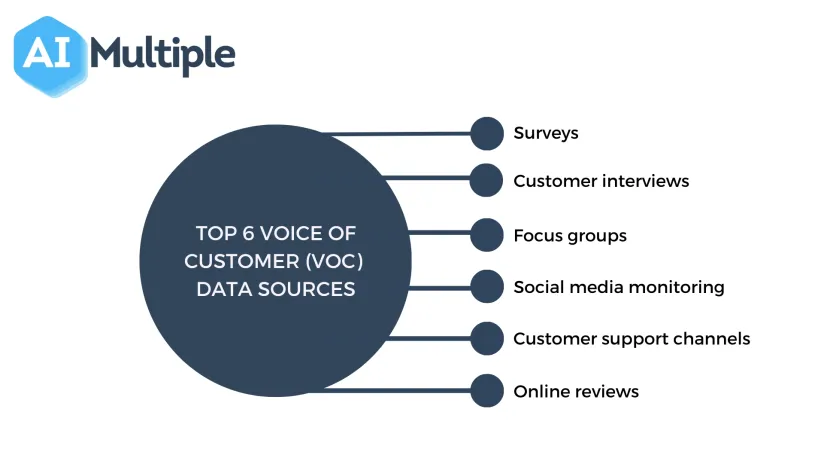Voice of Customer in 2024: An In-Depth Guide


In the fourth quarter of 2022, customer satisfaction in the U.S. was ~73% (See Figure 1). In today’s highly competitive business landscape, understanding customer data is more crucial than ever. One way to achieve this is by leveraging the Voice of Customer (VOC) methodology. This article will explore the concept of VOC, the steps in obtaining it, the top 6 data collection sources, and how to build a successful VOC program.
Source: American Customer Satisfaction Index
Figure 1. Change in customer satisfaction from 2000 to 2022 in the U.S.
What is the voice of the customer?
The Voice of Customer (VOC) is a research method that helps businesses capture and analyze customer needs, preferences, and expectations. In essence, VOC data
- Enables companies to be more customer-centric
- Heightens customer satisfaction
- Ensures brand loyalty
- Increases customer retention.
Top 6 data collection sources to listen to the voice of the customer (VOC)
Surveys
Create targeted surveys to gather feedback on specific aspects of your products or services. Online survey platforms make it easy to distribute and analyze surveys efficiently. According to research, 89% of marketers relied on online surveys to gather customer feedback in 2020.
Customer interviews
Conduct phone calls, online or face-to-face in-depth interviews with customers to better understand their needs, preferences, and experiences. By gathering direct feedback, you can understand customer pain points.
Focus groups
Assemble small groups of customers to discuss and share their thoughts on your products or services in a guided setting.
Social media monitoring
Monitor social media platforms for mentions of your brand and products, gathering valuable customer feedback and sentiment data. Especially negative feedback can be closely monitored to resolve any inconvenience.
Customer support channels
Analyze customer support phone calls, emails, and customer service chatbots to identify common issues and areas for improvement. This helps provide exceptional customer service.
Online customer reviews
Collect feedback from customers who have shared their experiences with your products or services through online reviews on websites or blogs.
What are the steps in obtaining the voice of the customer?
1- Set objectives
Start by defining the goals and purposes of your VOC initiative. Determine what insights you hope to gain from your customers and how this knowledge can be harnessed to benefit your business.
2- Segment customers
Break down your customer base into smaller segments, taking into account factors such as demographics, behaviors, or other relevant criteria. This approach allows you to target your efforts more effectively and collect representative feedback.
3- Select data collection methods
Based on your objectives and customer segments, choose suitable data collection methods. This may involve a combination of qualitative and quantitative approaches.
Check our comprehensive article to learn more about the essential steps in analyzing feedback.
4- Gather data
Implement your chosen data collection methods, making sure to obtain feedback from a diverse and representative customer sample.
5- Analyze data
Examine the data collected, identifying patterns, trends, and insights that can inform your business decisions.
6- Enact changes
Utilize the insights from your analysis to improve your products, services, and overall customer experience.
7- Monitor & iterate
Regularly measure the impact of your changes and make additional improvements as needed. Continuously reassess your VOC program to ensure it remains effective and relevant.
Top 5 Voice of Customer (VOC) use cases
1- Personalized marketing campaigns
Businesses are able to develop individualized marketing efforts that appeal to their target market by evaluating VOC data, and they can divide their customers into groups depending on their preferences, behaviors, and demographics. With the help of this information, customized messages, offers, and promotions can be created that can increase customer loyalty and conversion rates while also increasing engagement.
2- Customer experience optimization
Throughout the customer journey, VOC assists firms in identifying and addressing consumer pain points. Businesses can identify areas for improvement in their core products, website navigation, and customer support procedures by examining customer feedback and behavioral data. A more smooth and satisfying customer experience can be achieved by implementing adjustments based on these insights, which can promote brand loyalty and repeat purchases.
3- Predictive analytics for customer retention
Businesses employ VOC data in predictive analytics models to find at-risk clients and proactively solve their issues. Businesses can create focused retention strategies, increasing overall customer satisfaction and lowering attrition rates by identifying the variables that cause customer churn.
4- Competitive analysis
It is possible to do a competitive analysis using VOC data. Businesses can determine areas where they thrive or fall short by analyzing consumer feedback and sentiment among competitors in the same industry. This data can serve as a strategic decision-making tool, assisting companies in standing out from the competition and improving their competitive advantage.
5- Brand monitoring
Businesses may track their brand reputation in real-time using VOC data. Companies can quickly spot trends in consumer feedback especially using AI-powered customer feedback tools, allowing them to address issues and capitalize on positive feedback. This proactive method of brand monitoring can assist companies in keeping a strong online presence and improving consumer loyalty.
If you are interested, you can also check our benchmarking study on customer feedback tools.
If you have any questions about the voice of customer, don’t hesitate to contact us:

Cem has been the principal analyst at AIMultiple since 2017. AIMultiple informs hundreds of thousands of businesses (as per similarWeb) including 60% of Fortune 500 every month.
Cem's work has been cited by leading global publications including Business Insider, Forbes, Washington Post, global firms like Deloitte, HPE, NGOs like World Economic Forum and supranational organizations like European Commission. You can see more reputable companies and media that referenced AIMultiple.
Throughout his career, Cem served as a tech consultant, tech buyer and tech entrepreneur. He advised businesses on their enterprise software, automation, cloud, AI / ML and other technology related decisions at McKinsey & Company and Altman Solon for more than a decade. He also published a McKinsey report on digitalization.
He led technology strategy and procurement of a telco while reporting to the CEO. He has also led commercial growth of deep tech company Hypatos that reached a 7 digit annual recurring revenue and a 9 digit valuation from 0 within 2 years. Cem's work in Hypatos was covered by leading technology publications like TechCrunch and Business Insider.
Cem regularly speaks at international technology conferences. He graduated from Bogazici University as a computer engineer and holds an MBA from Columbia Business School.
To stay up-to-date on B2B tech & accelerate your enterprise:
Follow on

Comments
Your email address will not be published. All fields are required.